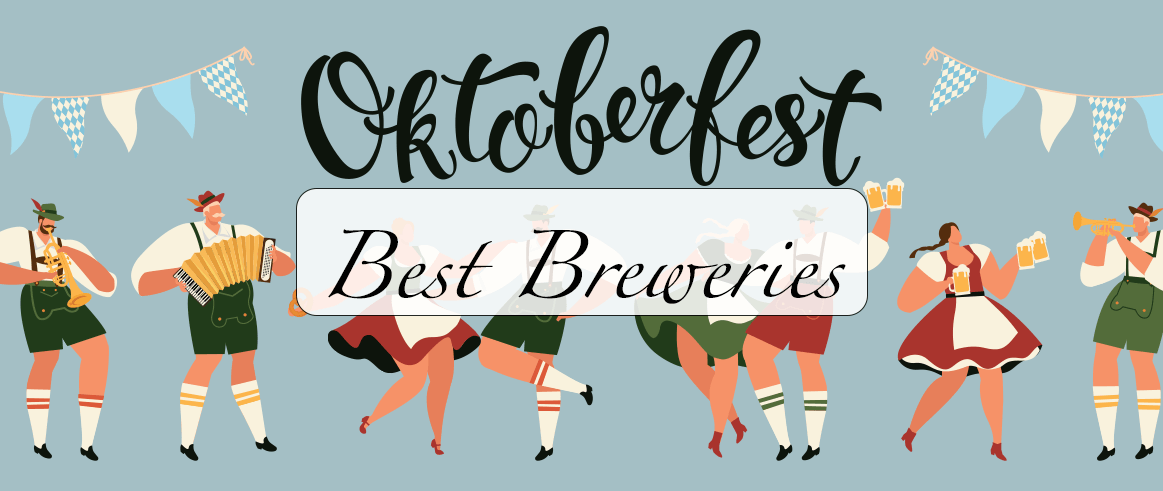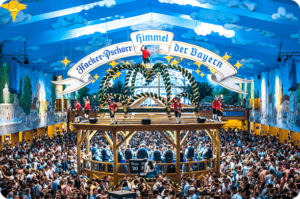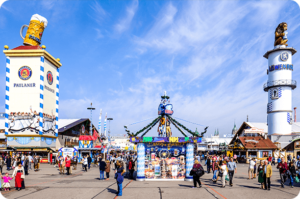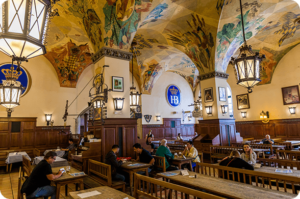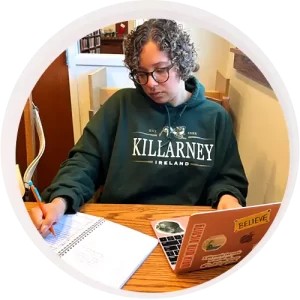Written by Jaden Parker
No Oktoberfest would be complete without its favorite beverage: beer! These rules were actually established in the Bavarian Purity Law created by Duke Wilhelm IV in 1516. It said that each beer had to have a minimum of 6% alcohol and only contain the following ingredients:wheat malt, yeast, cane sugar, water barely, and/or hops. Also, all beer must be brewed in Munich. With that being said, there are actually only six breweries, known as the “Big Six,” who produce beer in accordance with these guidelines for Oktoberfest. They are Augustiner, Hacker-Pschorr, Löwenbräu, Paulaner, Spaten, and Hofbräuhaus.
Augustiner
Augustiner is Munich’s oldest independent brewery still standing today after its foundation in 1328 by the Augustinian Hermits. They supplied beer to the Wittelsbach dukes until they made their own brewery, the Hofbräuhaus. When the monastery was dissolved in 1803, the dilapidated brewery eventually moved from its monasterial grounds in 1817. Anton and Therese Wagner became its new owners in 1829. Therese ran it for 14 years after the death of her husband until her son Joseph took over in 1858. Joseph Wagner was actually a founding member of the Bavarian Brewers’ Association!
In 1903, a large beer castle was placed at Oktoberfest to represent the Augustiner Brewery and was replaced with a giant festival hall in 1926 that still stands today. Unfortunately, 60% of it was destroyed in WWII. Out of the “Big Six,” it is the only brewery to tap its beer from wooden barrels. In 2013, Augustiner Klosterwirt opened, returning the brewery back to its original grounds of Munich’s Augustianian monastery.
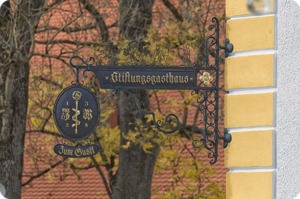
Hacker-Pschorr
Founded in 1417 as the Hacker brewery, the Hacker-Pschorr name didn’t come into existence until Joseph Pschorr married Maria Theresia Hacker in 1793. The name was split back up when sons Georg Pschorr and Mattias Hacker inherited one part each when their parents died. Fun fact: George Pschorr was godfather and grandfather to Richard Strauss, the German composer. In 1972, the name was reunited when the Schörghubers combined the breweries under them. “Himmel der Bayern” above their logos on the bottle labels means “The Heaven of the Bavarians.”
Löwenbräu
Although the bottles of Löwenbräu’s Weißbier say “since 1383,” this isn’t true, Jörg Schnaitter was Löwenbräu’s first brewer in 1524 in Munich at 17 Löwengrube, which translates to the “lion pit.” The Löwengrube name started in 1640 but was replaced by Löwenbräu, or “lion brew,” in 1746. George Brey took over as owner in 1818 and built three large beer cellars. Eventually, the brewery became Munich’s first large brewery plant in 1851. They maintained this title of being the largest brewery until Spatenbräu came into its own.
1883 saw Brey’s son Ludwig open their beer palace Löwenbräukeller. Joseph Schülein, owner of Unionsbräu, merged with Löwenbräu in 1921 after it was hit hard during WWI. Being Jewish, the Schüleins had to give up the brewery to their investors, the Fincks. Herman Schülein, son of Joseph, moved to America and worked with Rheingold Breweries. Now, Löwenbräu is just a small regional brand of Anheuser-Busch.
Paulaner
Neudeck ob der Au monks started brewing beer in 1634 to get through Lent. They named their beer the Salvator after the father of their order. In 1751, the monks were officially allowed to serve beer, so they invited the Bavarian Electors to enjoy the Salvator beer. This turned into a tradition that still goes on today where the head of Paulaner Brewery gives the first 1-liter of Salvator to the Bavarian minister president to start Munich’s Starkbierfest. It is now called the “Politiker Derblecken” where the local politicians are roasted!
Brother Barnabas (Monk Valentin Stephan Still) changes brewing approaches in 1772, which is still the way the Paulaner Salvator is made today. During post-secularization, Franz Xaver Zacherl took over in 1806. That’s why the Paulaner is sometimes called a “Zacherlbrew.” Paulaner Brewery had its first beer tents at Oktoberfest in 1818. In 1881, one of the first Carl von Linde ice machines was used in the brewery to serve beer year round. They also were the first to create the first non-alcoholic weissbier in the world in 1986.
After merging with Thomasbräu in 1989, they finally got their own brewhouse. The first Paulaner Bräuhaus outside was created in 1992 in Beijing, China, and its beer is enjoyed in 70+ countries today! They use copper brewing kettles; and in 2010, they were the first in the world to create the closed-loop beer pipeline with a beer supply being fed underground to their Oktoberfest tent.
Spaten
Having seen these bottles in my fridge on numerous occasions, I was delighted to find this brewery on the list of the “Big Six.” Duke Stephan II allowed anyone to get a brewing permit in 1372 because there was a drop in tax revenue and beer supply. So, Hans Welser founded a brewery in 1397. It was taken over by Georg Spät in 1622, hence the name Spaten. It became Oberspatenbräu in 1832 after Unterspatenbräu closed. Oberspatenbräu became the city’s largest brewery once Gabriel Sedlmayr took over.
Inspired by London breweries, Gabriel Sedlmayr introduced roasting malt through steam instead of smoke and was the first in Munich to use a thermometer. The brewery was moved to its current location at Maxvorstadt in 1851. The Spaten brewery, just like the other big five breweries of Germany, was deeply affected by the bombings of WWII. Its beer palace Arzberger Keller was destroyed and never rebuilt. When Gabriel Sedlmayr Jr. died, he gave one million gulden to each of his five daughters, severely hurting the Spaten brewery for good. This caused Spaten to merge with the other family-owned brewery, the Leistbräu, creating Spaten-Franziskaner-Leistbräu. In 1874, they teamed up with Löwenbräu and both were acquired by Interbrew in 2003.

Hofbräuhaus
Duke Wilhelm V founded Hofbräuhaus on September 27, 1589. The brewery was meant to sell beers solely to the Bavarian court. It was opened to the public in 1828 as a tavern by King Ludwig, the king whose first marriage to Therese created Oktoberfest. Fun fact: In 1632, Hofbräuhaus gave Swedish troops 23,168 liters of beer to keep them from destroying Munich! Hofbräuhaus registered their HB-logo as a trademark in 1879 and relocated to the center of Munich 17 years later to the location where Hofbräukeller is now. In 1988, the brewery moved to the Riem district.
Hofbräuhaus also has interesting lore around their frequent customers. The “regulars” can store their own stein of beer in one of the tavern’s 616 compartments! Their most well-known regular is Angel Aloisius. Based on the story “A Munich Man in Heaven” by Ludwig Thoma in 1911, Alois Hingerl was a regular of Hofbräuhaus who had a stroke while working as a porter. He was taken to heaven but soon sent back to Earth with a mission after being frustrated by heaven’s lack of beer and snuff. His mission? To give divine advice to the Bavarian government. However, his first stop was the Hofbräuhaus, where he’s been sitting ordering beers to this day!
If you’re like me, you have a really long travel bucket list that seems to get longer every day. And now because I have to add all these amazing breweries, I might need to extend my visit to Germany someday. But how can I make sure to see Munich’s best and brightest while staying safe? That’s where ALLMYNE comes in. With ALLMYNE, I am connected with local guides who know my personalized itinerary and can show me all the little things I wouldn’t have known about. ALLMYNE takes the stress out of vacation planning and traveling abroad by keeping track of your memories and locations. Travel with ALLMYNE.
